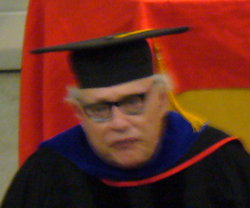Biography:Stephen E. Harris
Stephen E. Harris | |
|---|---|
 Stephen Harris | |
| Born | November 29, 1936 Brooklyn, New York |
| Nationality | United States |
| Alma mater | Stanford University Rensselaer Polytechnic Institute |
| Scientific career | |
| Fields | Physics |
| Institutions | Stanford University |
| Doctoral advisor | Anthony E. Siegman |
| Doctoral students | Robert L. Byer, Ataç İmamoğlu |
Stephen Ernest Harris (born November 29, 1936) is an American physicist known for his contributions to electromagnetically induced transparency (EIT),[1][2] modulation of single photons, and x-ray emission.
In a diverse career, he has collaborated with others to produce results in many areas, including the 1999 paper titled “Light speed reduction to 17 metres per second in an ultracold gas,”[3] in which Lene Hau and Harris, Cyrus Behroozi and Zachary Dutton describe how they used EIT to slow optical pulses to the speed of a bicycle. He has also contributed to developments in the use of the laser, generating paired photons with single driving lasers[4] He has also shown the development of such pairs of photons using waveforms[5]
His more recent work has sought to address restraints imposed on the types of waveforms that can be produced by the single-cycle barrier[6] Harris and colleagues succeeded in this endeavour in 2005 during a series of experiments aimed at obtaining full control of waveforms, noting "we were able to vary the shape of the pulse to generate different prescribed waveforms."[7] It is hoped that these results will lead to coherent control of chemical reactions, as a probe for ever-shorter physical processes, and for highly efficient generation of far infra-red and vacuum ultra-violet radiation.
Harris was elected as a member into the National Academy of Engineering in 1977 for contributions in the field of coherent and non-linear optics.
Education
- 1959 B.S., Electrical Engineering, Rensselaer Polytechnic Institute
- 1961 M.S., Electrical Engineering, Stanford University
- 1963 Ph.D., Electrical Engineering, Stanford University
Awards
This section of a biography of a living person does not include any references or sources. (October 2017) (Learn how and when to remove this template message) |
- 1973 Curtis W. McGraw Research Award (American Society for Engineering Education)
- 1978 David Sarnoff Award (The Institute of Electrical and Electronics Engineers)
- 1984 Davies Medal for Engineering Achievement (Rensselaer Polytechnic Institute)
- 1985 Charles Hard Townes Award (Optical Society of America)
- 1991 Einstein Prize for Laser Science (International Conference on Lasers and Applications)
- 1992 Optical Society of America (Stanford Chapter) Teaching Award
- 1994 Quantum Electronics Award (The Institute of Electrical and Electronics Engineers)
- 1999 Frederic Ives Medal (highest award of the Optical Society of America)
- 2002 Arthur L. Schawlow Prize in Laser Science (American Physical Society)
- 2007 Harvey Prize (Awarded by the Technion-Israel Institute of Technology)
- 2020 Willis E. Lamb Award for Laser Science and Quantum Optics[8]
Honours
- 1968 Fellow of the Optical Society of America
- 1972 Fellow of the Institute of Electrical and Electronics Engineers
- 1975 Fellow of American Physical Society
- 1976 Guggenheim Fellowship
- 1977 Elected to the National Academy of Engineering
- 1981 Elected to the National Academy of Sciences
- 1988 Kenneth and Barbara Oshman Professor of Engineering Endowed Chair (Stanford University)
- 1994 Fellow of the American Association for the Advancement of Science
- 1995 Elected to Fellow of the American Academy of Arts and Sciences
- 2005 Stephen E. Harris Endowed Professorship in Quantum Optics (Texas A&M University)
References
- ↑ Harris, S. E. (1989). "Lasers without inversion: Interference of lifetime-broadened resonances". Physical Review Letters 62 (9): 1033–1036. doi:10.1103/PhysRevLett.62.1033. PMID 10040407. Bibcode: 1989PhRvL..62.1033H.
- ↑ Boller, K.-J.; Imamoğlu, A.; Harris, S. E. (1991). "Observation of electromagnetically induced transparency". Physical Review Letters 66 (20): 2593–2596. doi:10.1103/PhysRevLett.66.2593. PMID 10043562. Bibcode: 1991PhRvL..66.2593B.
- ↑ Hau, Lene Vestergaard; Harris, S. E.; Dutton, Zachary; Behroozi, Cyrus H. (February 1999). "Light speed reduction to 17 metres per second in an ultracold atomic gas". Nature 397 (6720): 594–598. doi:10.1038/17561. http://nrs.harvard.edu/urn-3:HUL.InstRepos:3636967.
- ↑ Du, Shengwang; Kolchin, Pavel; Belthangady, Chinmay; Yin, G. Y.; Harris, S. E. (2006). "Generation of Narrow Bandwidth Paired Photons: Use of a Single Driving Laser". Slow and Fast Light. pp. TuA2. doi:10.1364/SL.2006.TuA2. ISBN 1-55752-816-0.
- ↑ V. Balic, D. A. Braje, P. Kolchin, G. Y. Yin, and S. E. Harris, "Generation of Paired Photons with Controllable Waveforms," Phys. Rev. Lett. 94, 183601-1/183601-4 (May 2005).
- ↑ M. Y. Shverdin, D. R. Walker, S. Goda, G. Y. Yin, and S. E. Harris, "Breaking the Single-Cycle Barrier," Photonics Spectra 39, 92-105 (February 2005).
- ↑ Breaking the Single-Cycle Barrier
- ↑ The Willis E. Lamb Award for Laser Science and Quantum Optics [1]
External links
 |

